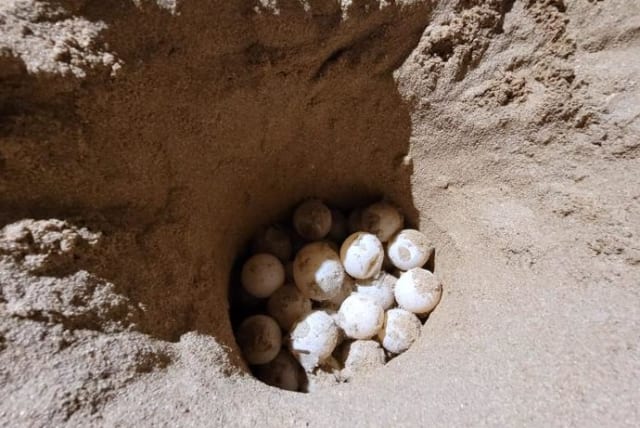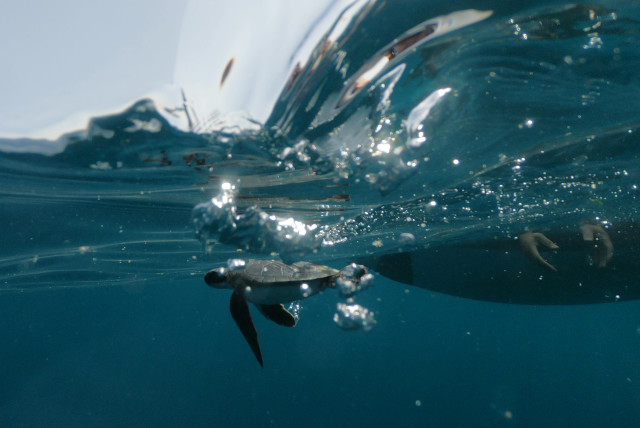First sea turtle nest of the season spotted in Acre

Sea turtle nesting season begins around this time every year on Israel's Mediterranean coast and lasts until September.
The first sea turtle nest of the season was discovered in Acre overnight Monday, the Israel Nature and Parks Authority said Tuesday.
A brown sea turtle laid 44 eggs in a nest that an authority inspector moved to a protected sea turtle hatchery in Rosh Hanikra.
Sea turtles are an endangered species. According to the authority, there are only an estimated 2,500 female nesting loggerhead sea turtles and 450 nesting female green turtles in the Mediterranean. That number is even lower in Israel, with about 150 loggerheads and 15 green sea turtles.
Sea turtle nesting season begins around this time every year on Israel's Mediterranean coast and lasts until September, the authority explained. During this time, the females go ashore, dig nests, lay their eggs and return to sea. Female sea turtles leave clear footprints that can help authority inspectors locate and preserve their nests.
Generally, these turtles will lay their eggs in the same area where they hatched. However, with increasing human use of Israeli beaches, the laying sites of these turtles have been damaged over the years, making reproduction difficult. Residential and tourism construction, restaurants, roads, factories, marinas and harbors reduce the beach area available to the nesting female. Noise, bright lights and human presence on the beaches at night also disturb them.
Because the female sea turtle is sensitive to any disturbance, if she does not find a suitable place to lay her eggs, she will keep them inside her until she does. Some nights, she can surface but return to the sea without laying her eggs. She may try again the next day, but she could also decide to lay them in the sea, which leaves zero chance of survival for her baby turtles. Alternatively, she could keep them inside her body until they rot and kill her.
The Nature and Parks Authority has been working to protect sea turtles since the 1980s but needs the public's help to ensure their safety. Therefore, the authority asks beachgoers to keep their eyes open for these animals and their eggs.
Nests left on the beach will likely be damaged by human activity or eaten by animals. If they do hatch, the young turtles will be exposed to multiple dangers, such as being trampled by people, vehicles or animals, disoriented by the bright lights or suffering from air pollution.
What should you do if you spot sea turtle tracks or a nest?
1 - Report: Call *3639 and report the exact location of the finding. Take pictures.
2 - Preserve: Do not touch, smear, dig or stab the tracks or nest.
3 - Protect: Keep other people, vehicles or animals away from the tracks or nest until a professional arrives.
4 - Do not interfere. Only professionals can relocate these nests. Attempting to do it on your own could cause the unborn sea turtles to die.
Sometimes, you can also come across a nesting sea turtle. Here, too, you should call *3639 with a full report. In addition:
1 - Keep a distance of at least 20 meters from the sea turtle and try not to disturb her.
2 - Do not take pictures with a flash, nor shine a flashlight or other light on the turtle. It could drive her away in the middle of her egg-laying.
3 - Do not obscure the tracks the sea turtle leaves, and do not touch the nest. However, stay close to the footprints and nest until an inspector arrives.
The authority warned that it is forbidden to deliberately search for nesting female sea turtles.
"This is a serious disturbance to a protected wild animal," the authority said.
The Environment and Climate Change portal is produced in cooperation with the Goldman Sonnenfeldt School of Sustainability and Climate Change at Ben-Gurion University of the Negev. The Jerusalem Post maintains all editorial decisions related to the content.
Jerusalem Post Store
`; document.getElementById("linkPremium").innerHTML = cont; var divWithLink = document.getElementById("premium-link"); if (divWithLink !== null && divWithLink !== 'undefined') { divWithLink.style.border = "solid 1px #cb0f3e"; divWithLink.style.textAlign = "center"; divWithLink.style.marginBottom = "15px"; divWithLink.style.marginTop = "15px"; divWithLink.style.width = "100%"; divWithLink.style.backgroundColor = "#122952"; divWithLink.style.color = "#ffffff"; divWithLink.style.lineHeight = "1.5"; } } (function (v, i) { });

